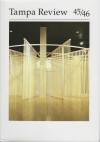Tampa Review – 2013
If you are a starving artist, take $22 from your last hundred bucks and purchase a subscription to Tampa Review. Every time you behold the volumes, you will feel rich. This journal is one of the most lavish and beautiful publications in the world of literary magazines. Hardcover, with a four-color dust jacket and visual art throughout, the large-format Tampa Review is an instantaneous wow. The dust jacket flaps contain an eloquent orientation to the content, indicating the editorial goal of creating an integrated experience within each single issue. Contributor notes are relatively lavish, providing almost five pages of information about the 55 artists and writers represented in this issue.
If you are a starving artist, take $22 from your last hundred bucks and purchase a subscription to Tampa Review. Every time you behold the volumes, you will feel rich. This journal is one of the most lavish and beautiful publications in the world of literary magazines. Hardcover, with a four-color dust jacket and visual art throughout, the large-format Tampa Review is an instantaneous wow. The dust jacket flaps contain an eloquent orientation to the content, indicating the editorial goal of creating an integrated experience within each single issue. Contributor notes are relatively lavish, providing almost five pages of information about the 55 artists and writers represented in this issue.
The journal, published by the faculty of the University of Tampa, features visual art that complements, not to say illustrates, various of its literary selections. The journal wants to be known as “a gallery space in print,” embracing art, conversations, essays, fiction, poetry, creative nonfiction, and translations. Editor Richard Matthews produces the journal with a relatively small staff. Contributors feature Florida writers, but include writers from around the world. As Tampa Review celebrates its 50th year in 2014, it can claim pride of place on any shelf of contemporary literary magazines.
This issue opens with a photograph of the sculptural installation featured on the cover, followed by a poem, followed by two digital photographs, followed by a short story. The editors appear to have an organic concept of the journal’s content, an idea perhaps that the reader will read the issue from front to back with a strong sense of a throughline. As a result, it is not always immediately evident whether a prose piece is fiction or essay. A first-person narrator may be telling a story or recounting a memoir. Any uncertainty is quickly resolved by a moment of close reading, however. This “Cuz” and the absence of quotation marks around dialogue must mean fiction, in Mark Krieger’s “Scar.” In fact, Krieger’s work is the current winner of the journal’s short fiction prize. And Mark Beaver’s “Lone Baritone,” a lovingly detailed account of a turning point he reached in sixth grade, is memoir.
Matthew Vollmer’s “Winter Wedding,” the melancholy last work of prose featured in this issue, limns a feckless middle-aged man full of regret who maintains the crazy hope of re-encountering his former wife after decades alone; his role in his daughter’s wedding; his discomfort in his own skin. The story is beautiful and sad. After this, we read Rachel Hadas’s powerful poem “Aubade: The Nest,” a densely imaged evocation of the twined pain and exaltation in sharing childcare. Why is Marjorie Stelmach’s poem “Autumn Dialogue” the last work in this issue? The editors hint (in the dust jacket notes) that it is because the speaker is elderly, balancing the image of dawn that appears at the beginning of the volume, in M.P. Jones IV’s “A Prayer for Lethe.”
Each work of visual art, specifically selected to pair with one of the literary works, has been either commissioned or found. “Lone Baritone” is accompanied by a digital pen-and-ink work of the same name by the Croatian-born Daniel Mrgan. And Virginia Pye’s bleak story “White Dog” is illustrated by Neverne Covington’s charcoal drawing of a menacing “White Dog.” Serendipity may explain the pairing of Dan Taylr’s 2008 manipulated photograph “Level 2” with Gina P. Vozenilek’s bittersweet (aren’t they all?) memoir “Tri-level”; and creation of the imaginative soil-on-cardboard “Soil Flowers” by José Lerma that accompanies “The Shadows of a Queen Bee” by Caroline Sutton predates the memoir. Sutton’s delectable work blends a meditation on gardening with reflections on mortality and mystery, making the choice of the soil-on-cardboard medium particularly apt.
Ann Keniston is represented by four strong poems, filling two double-page spreads. Keniston here is fascinated with skin, perhaps symbolizing inside/outside or the two-edged awareness of being embodied. The images capture the ick factor. “The afflicted body itches,” the poet observes in “Morgellons Syndrome,” and a daughter in “Coming of Age” “goes to her room and tries to chip off / something from herself.” The essays in this issue include J. Malcolm Garcia’s account of connections to Afghanistan and Ellis J. Biderson’s recollections from his second career as a teacher of writing—both works blessed with a searing self-awareness that elevates the narratives from journal entry to literary art.
This journal is a treat for the eye, the heart, and the mind. Its editorial sensibility as well as its physical beauty will reward the reader at first glance and justify repeated consideration of all its richness.
[www.ut.edu/tampareview]





